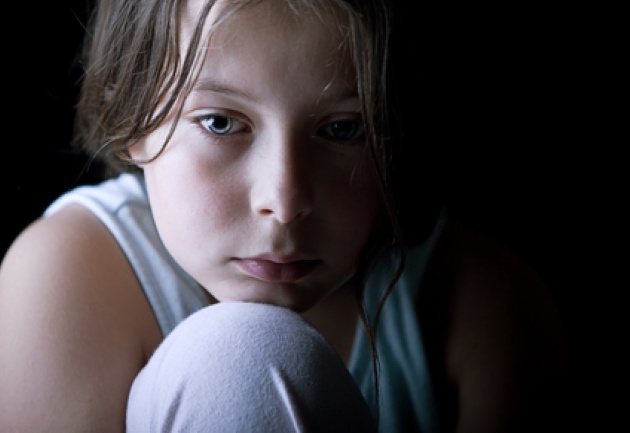Does your child seem more worried or fearful than other children their age? Does your child become clingy or have tantrums when she separates from you? Does your son or daughter show resistance to normal activities such as bedtime, birthday parties, school drop offs or field trips that other children seem to engage in effortlessly? Do you find yourself frequently coaxing or trying to persuade your child to try new things or meet new people? All of these behaviors can be indicators of an anxiety problem. The signs of anxiety can be seen in very young children but if managed well at a young age, anxiety disorders can be prevented.
Some children are born with a personality style that is more cautious or inhibited. These children tend to anticipate or focus on the dangerous aspects of situations (for example, a bee flying nearby will sting, a dog will bite, or mom will forget to pick them up), overestimating threats and underestimating the possibility of good outcomes or their ability to cope well with difficult situations. This tendency to look for danger or threat creates significant worry and distress for these children, causing them to be overly fearful and leading to avoidance of experiences important for their development. The good news is that over cautious children can be taught to see situations from a more realistic and positive perspective.
There are factors other than personality style that put children at risk for the development of an anxiety disorder. Trauma of any kind such as car accidents, abuse, or environmental disasters can create significant and persistent anxiety. Any major changes in a child’s life, for example parental divorce, death of a loved one or frequent moves, can also lead to anxiety problems. It is important that parents, caregivers and teachers be aware of the signs and symptoms of anxiety so they can help children early on and prevent the development or ease the symptoms of anxiety.
Anxiety disorders are the most common mental health problem for children and youth. If your child is showing signs of anxiety, you are not alone. It is estimated that up to 1 in 4 young people experience above normal anxiety that interferes with their daily lives, including their social, emotional and/or school functioning. Research has shown there are a number of strategies children can be taught that help prevent and treat anxiety disorders.
Common signs of anxiety in children are excessive worry or fears, clingy behavior or upset on separation from a parent or caregiver, refusal to participate in normal activities, excessive shyness and physical symptoms such as stomach aches, headaches and sleeplessness.
Strategies that have been shown to help reduce anxiety include education about anxiety, relaxation skills, positive thinking style and facing fears.
Step 1;Education on anxiety involves teaching young people that anxiety is normal and common. It is important for children to understand that the feelings associated with anxiety (rapid heartbeat, stomach ache, blushing) can be uncomfortable but not dangerous. Children are empowered by learning there are things they can do to calm themselves and lessen their anxiety symptoms.
Step 2;
Learning relaxation strategies, including calm breathing and muscle relaxation, is an important skill in managing anxiety.
Calm Breathing; This is a strategy that your child or teen can use to calm him or herself down quickly. You can explain to your child that we tend to breathe faster when we are anxious. This can make us feel dizzy and lightheaded, which can make us even more anxious. Calm breathing involves taking slow deep breaths. Encourage your child to breathe in through the nose, pause, and then breathe out through the mouth, pausing several seconds before taking another breath. For younger children, have them imagine that they are blowing huge bubbles that slowly rise and float away. Make sure your child's breathing is slow and gentle.
Muscle Relaxation; Another helpful strategy is to help your child or teen learn to relax his or her body. This involves having your child tense various muscles and then relax them. You can also have your child use "the flop," which involves having your child imagine that he or she is a rag doll and relax the whole body at once. (from www.anxietybc.com)
Step 3;
Positive thinking involves bossing back or challenging scary thoughts that are likely unrealistic and overly negative. Children can be taught to think in helpful ways that reduce anxiety and build confidence.
Step 4;
Facing fears requires that children do not avoid situations that scare them but rather approach these situations with support and the above coping strategies. Avoiding anxiety-provoking situations may reduce distress in the short term but it makes anxiety worse in the long term, creating a habit of avoidance and causing children to miss out on important and enjoyable activities.
Anxiety problems can be very distressing for children and their families. Anxiety often goes untreated as parents assume children will grow out of their fears and difficult behaviors. In fact, if left untreated, anxiety can develop into serious mental health problems such as depression. It is important to help children develop effective coping strategies that can reduce their worry and distress and offset anxiety and depression as they age.
The internet has many great resources on anxiety in children and youth and helpful strategies and tips for children and parents. One particularly good site is www.anxietybc.com. If you feel you need additional support for your child, please contact your family physician or a mental health professional.
About the
Author;
AnnMarie Churchill is currently developing
a program for psychological resilience and mental health promotion. AnnMarie has
a Ph.D in Experimental Psychology and a post doctoral specialization in the
treatment of anxiety disorders. She has worked as a clinician and mental health
consultant for over 25 years. AnnMarie has been a senior trainer for the
Friends for Life, Anxiety Prevention Program since 2004.

 In The Latest Issue:Latest Issue:
In The Latest Issue:Latest Issue:
- A Bittersweet Farewell
- The new Laval Aquatic Co...
- The End of an Era:
Articles
Calendar
Virtual- ANNUAL TEACHER APPRECIATION CONTEST
- APPUI LAVAL
- ARTS & CULTURE
- CAMPS
- CAR GUIDE
- CCIL
- CENTENNIAL ACADEMY
- CHARITY FUNDRAISING
- CITYTV
- COSMODÔME
- COMMUNITY CONNECTIONS
- COVER STORY
- DINA DIMITRATOS
- ÉCOLE SUPÉRIEURE DE BALLET DU QUÉBEC
- EDITORIALS
- ÉDUCALOI
- EDUCATION
- EMPLOYMENT & ENTREPRENEURSHIP
- FÊTE DE LA FAMILLE
- FÊTE DU QUARTIER SAINT-BRUNO
- FAMILIES
- FESTIVAL LAVAL LAUGHS
- FÊTE DE QUARTIER VAL-DES-BRISES
- FINANCES
- GLI CUMBARE
- GROUPE RENO-EXPERT
- HEALTH & WELL-BEING
- 30 MINUTE HIT
- ANXIETY
- CHILDREN`S HEALTH & WELLNESS
- CLOSE AID
- DENTAL WELLNESS
- EXTREME EVOLUTION SPORTS CENTRE
- FONDATION CITÉ DE LA SANTÉ
- GENERAL
- HEARING HEALTH
- MESSAGES FROM THE HEALTH AGENCY OF CANADA
- MENTAL HEALTH
- SEXUALITY
- SOCIAL INTEGRATION
- SPECIAL NEEDS
- TEENS
- THE NUTRITION CORNER
- THE NUTRITION CORNER - RECIPES
- VACATION DESTINATION
- WOMEN'S FITNESS
- WOMEN'S HEALTH
- HILTON MONTREAL/LAVAL
- HOME & GARDEN
- INTERNATIONAL WOMEN'S DAY
- JAGUAR LAVAL
- LAVAL À VÉLO
- LAVAL FAMILIES TV SHOW
- LAVAL FAMILIES MAGAZINE CARES
- LAVAL URBAN IN NATURE
- LE PARCOURS DES HÉROS
- LES PETITS GOURMETS DANS MA COUR
- LEON'S FURNITURE
- LEONARDO DA VINCI CENTRE
- LFM PREMIERES
- LIFE BALANCE
- M.P. PROFILE
- MISS EDGAR'S AND MISS CRAMP'S SCHOOL
- MISSING CHILDREN'S NETWORK
- NETFOLIE
- NORTH STAR ACADEMY LAVAL
- OUTFRONT MEDIA
- PASSION SOCCER
- PARC DE LA RIVIÈRE-DES-MILLE-ÎLES
- PÂTISSERIE ST-MARTIN
- PIZZERIA LÌOLÀ
- PLACE BELL
- PORTRAITS OF YOUR MNA'S
- ROCKET DE LAVAL
- SACRED HEART SCHOOL
- SCOTIA BANK
- SHERATON LAVAL HOTEL
- SOCIÉTÉ ALZHEIMER LAVAL
- STATION 55
- STL
- SUBARU DE LAVAL
- TECHNOLOGY
- TEDXLAVAL
- TODAY`S LAURENTIANS AND LANAUDIÈRE
- TODAY`S LAVAL
- WARNER MUSIC
- THIS ISSUE
- MOST RECENT
Magazine
Anxiety in Children and Adolescents
Articles ~e 105,7 Rythme FM 4 chemins Annual Teacher Appreciation Contest Appui Laval Arts & Culture Ballet Eddy Toussaint Camps THIS ISSUE MORE...
CONTESTS Enter our contests
CONTESTS Enter our contests
CALENDAR
Events & Activities
COMMUNITY Posts Events
PUBLICATIONS Our Magazine Family Resource Directory
LFM BUSINESS NETWORK Learn more
COUPONS Click to save!
COMMUNITY Posts Events
PUBLICATIONS Our Magazine Family Resource Directory
LFM BUSINESS NETWORK Learn more
COUPONS Click to save!
SUBSCRIPTIONS
Subscribe to the magazine
Un-Subscribe
E-NEWSLETTER Subscribe to our E-newsletter Un-Subscribe
WRITE FOR US Guidelines & Submissions
POLLS Vote today!
E-NEWSLETTER Subscribe to our E-newsletter Un-Subscribe
WRITE FOR US Guidelines & Submissions
POLLS Vote today!
ADVERTISERS
How to & Media guide
Pay your LFM invoice
SUGGESTIONS Reader's Survey Suggest a Listing
LFM About Us Our Mission Giving Back Contact Us
SUGGESTIONS Reader's Survey Suggest a Listing
LFM About Us Our Mission Giving Back Contact Us
 PICK-UP LOCATIONS
Get a copy of LFM!
PICK-UP LOCATIONS
Get a copy of LFM!
TERMS & CONDITIONS Privacy | Terms
ISSN (ONLINE) 2291-1677
ISSN (PRINT) 2291-1677
Website by ZENxDESIGN



 BY:
BY: 
Tweet
Share